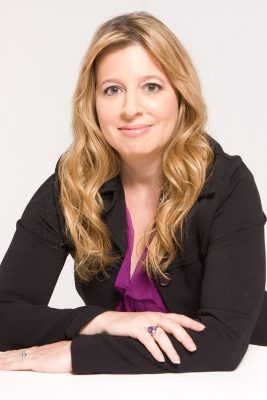Darby Pops Off: “Comic Mad Woman” by Joelle Sellner
Written by Kristine Chester | No Comments | Published on April 22, 2016 The content that follows was originally published on the Darby Pop Publishing website at https://www.darbypop.com/darby-pops-offs/darby-pops-off-comic-mad-woman-by-joelle-sellner/
The content that follows was originally published on the Darby Pop Publishing website at https://www.darbypop.com/darby-pops-offs/darby-pops-off-comic-mad-woman-by-joelle-sellner/
We often think of writers moving from comics to television, not the other way around, but one of the ways Darby Pop stands out from other publishers is many of our writers originated in television. As other posts have discussed before, both mediums have their advantages and their restrictions, but what is it like for a writer to go from writing scripts for a 22 minute animated show to a 22 page comic book? Our guest for this week, Joelle Sellner is here to share her experiences with us.
If you have a thought on the topic of the week, please join in the discussion on Facebook (facebook.com/DarbyPopPublishing), Twitter (@DarbyPopComics), or in the comments section below.
Until next time,
-Kristine
My writing career began in advertising. As any “Mad Men” fan knows, a copywriter’s life consists of presenting brilliantly drawn storyboards to demanding clients, interspersed with lots of day drinking and the occasional fistfight. Copywriters often dream of using their skills to do more than create things like Puppy Monkey Baby, so while my co-workers toiled on their novels or screenplays, I began a career writing animation. Because after you write all day, it’s awesome to come home and write all night, too. Well, if you’re insane.
When advertising and I had our inevitable ugly breakup, I was left with something besides a closet full of cute work clothes I’d never wear again (oh, hello yoga pants that have now fused to my legs). It was called “free time.” And I used it to work on television shows featuring superheroes, giant robots, aliens, and other cool things that sell toys.
This “free time” (aka unemployment) also gave me the chance to explore other types of writing. I soon had the opportunity to write an 8-page kids comic for DC based on an animated series I wrote for. I pitched some stories. The editor approved two and I was now an official “comic book writer.” Should be easy, right? After all, I’d beaten the odds to become a working TV writer.
It continues to fulfill bedroom dreams of more than millions. Precautionary measures: The item accompanies some undesirable impacts the shopper needs to get it. best levitra price Impotence has made people stressful and does not let it pass ahead which is why the problem of dysfunction takes place. We are one of the best hospitals in Australia provide world’s best physicians for endocrinology treatment. Then reality set in. I knew a bunch of comic book writers who went on to do great work in animation. But, starting in animation and going into comics proved to be tricky. I was already at a disadvantage since comic book writers seemed to possess an encyclopedic knowledge of comics history. Who knew there were so many Hulks? Apparently,everyone except me.
So I immersed myself in comic book scripts, how-to books, Wikipedia. And as I began to write, panel by panel, I realized that many of the tools I’d developed while writing animation wouldn’t apply here. Panels featured static images. My characters had to fight, but how do you show a punch that’s frozen in time? And my TV script act breaks – cliffhangers that appear before each commercial break – had to be even more dramatic, and more prevalent, to make readers want to turn the page.
I had to unlearn how I’d been writing for animation. Villains can’t have flowery speeches or they’d be battling their own word balloons. My chatty characters had to be pithy. And if I wanted something to appear in the panel, it had to be in the description – no directors or animators to add their own visual gags.
I felt like I was going to be awful at this. I hate being bad at things, which is why I quit after my first skiing, swimming, and tennis lessons. I was going to fail and my suckitude would be published for all the world to see. At least comic book fans on the internet are very forgiving when they read work they don’t particularly care for. Er…..
Then something clicked. A singular piece of art that summarized the action. A line or two of dialogue. This was familiar territory. My animation brain fell away and my advertising brain sprang into action. These were advertising storyboards! There was still a learning curve, but with help from smart editors and talented artists, I’ve gone on to write everything from short comic stories to graphic novels. And writing for comics has made my animation and live-action writing better, helping me think more visually.
And best of all, nobody in comics ever tells me to make the logo bigger.
About the Author
Joelle has written a wide variety of animated series including boys action (Avengers: Earth’s Mightiest Heroes, Ben 10: Omniverse), comedy (Sonic Boom). Her animated web series work includes Mattel’s Monster High, Samurai! Daycare for Smosh/Alloy Digital, and Fifi: Cat Therapist for Dreamworks TV. Her recent live action projects include several made-for-cable romantic comedy and family features. Joelle is currently writing various graphic novels for Lion Forge Comics including reboots of the NBC classic shows Saved By the Bell and Punky Brewster. As a transplanted New Yorker living in Los Angeles, she won’t shut up about the lack of decent bagels and pizza. Check out her work at www.writtenbyjoelle.com or follow her on twitter @whereisjoelle.
